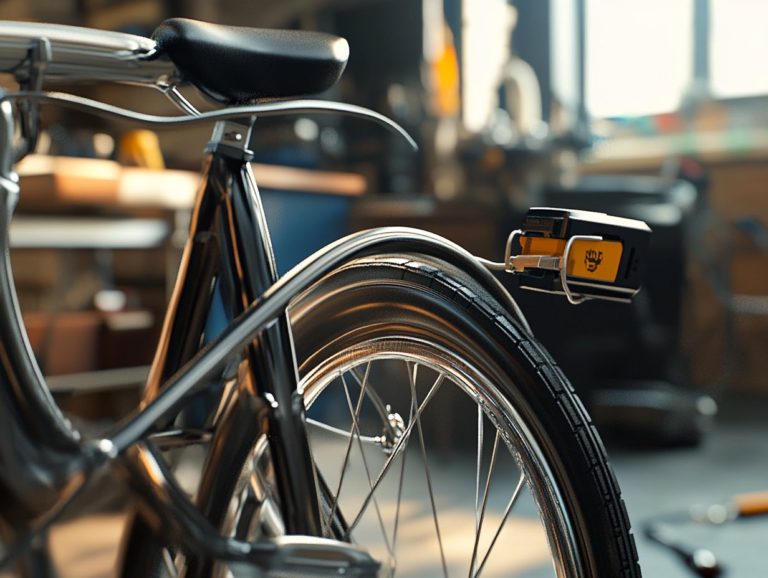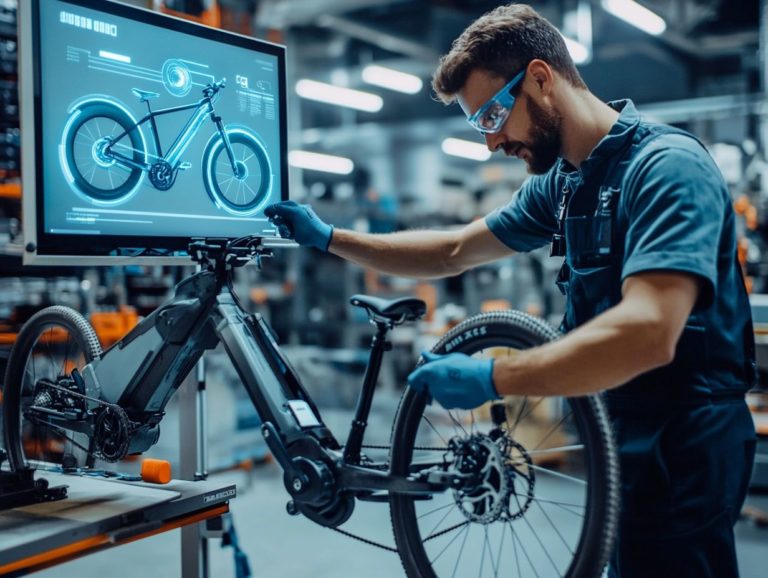The Essential Guide to Electric Bicycle Components
Electric bicycles have revolutionized commuting, providing an eco-friendly alternative to conventional transportation.
By grasping the key components of an electric bike, you can significantly enhance your riding experience and make informed choices. Each part from batteries to motors plays a vital role in performance and functionality.
This guide delves into the essential components of electric bicycles, illustrating how they work in harmony and offering invaluable tips for selection and maintenance.
Prepare to unlock the full potential of your ride!
Contents
- Key Takeaways:
- Types of Electric Bicycle Components
- How Components Work Together
- Choosing the Right Components for Your Electric Bicycle
- Maintaining and Upgrading Electric Bicycle Components
- Frequently Asked Questions
- What are the essential components of an electric bicycle?
- What is the role of the motor in an electric bicycle?
- How does the battery work in an electric bicycle?
- What is the function of the controller in an electric bicycle?
- Do all electric bicycles have a display unit?
- Can electric bicycle components be upgraded or replaced?
Key Takeaways:
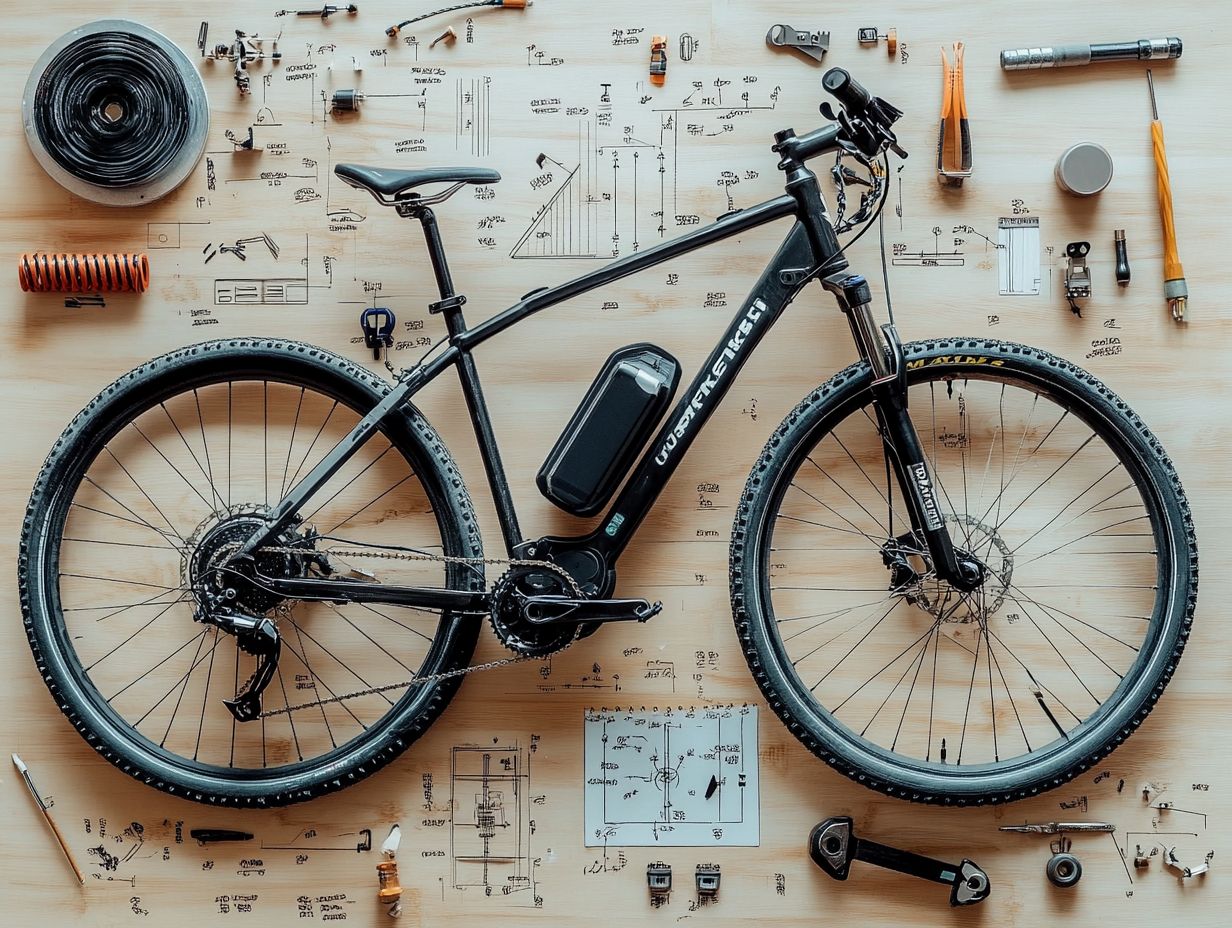
- Battery, motor, and controller are the three essential components that make up an electric bicycle’s power system.
- The pedal assist sensor and throttle are key components that determine how much assistance the motor provides while riding.
- To ensure optimal performance and longevity, it’s important to choose high-quality components, properly maintain them, and consider upgrading as needed.
What are Electric Bicycles?
Electric bicycles, or e-bikes, are transforming your approach to traditional transportation. They present a sustainable travel solution that greatly reduces carbon emissions. With advanced features like rechargeable batteries and pedal assist systems, commuting becomes not only easier but also more enjoyable.
E-bikes seamlessly connect the realms of conventional bicycles and motor vehicles, offering an efficient alternative for both urban settings and recreational pursuits.
As their popularity surges, e-bikes have established themselves as a staple in numerous cities. They attract a wide range of enthusiasts from daily commuters to weekend adventurers. The technology behind e-bikes varies across models, including city bikes, mountain bikes, and folding bikes, each designed to meet specific needs.
One of the most compelling advantages of e-bikes is their potential to alleviate traffic congestion while encouraging healthier lifestyle choices. By harnessing clean energy, these bicycles help reduce urban pollution, positioning themselves as vital contributors to the movement toward sustainable travel solutions.
As more individuals embrace e-bikes, they revolutionize personal transport and inspire a broader shift toward environmentally conscious living.
Types of Electric Bicycle Components
Electric bicycles are composed of several essential components that collaborate seamlessly to elevate your riding experience. These include the battery, motor, controller, display, throttle, and pedal assist sensor.
Each of these elements is crucial in shaping your bike’s performance, efficiency, and overall rideability. To maintain these aspects, it’s important to have the essential tools every electric bicycle owner should have. Discover how these components work together to enhance your appreciation of the technology behind your ride.
Battery
The battery is a crucial component of electric bicycles, primarily influencing their range and performance. You ll find that Lithium-ion batteries are the go-to choice due to their impressive battery capacity and longevity.
This selection plays a significant role in your e-bike’s overall efficiency and dictates how often you ll need to recharge. As a rider, you may come across various battery types, such as Nickel-Metal Hydride and Lead-Acid, each presenting its own unique advantages and disadvantages.
For example, while Nickel-Metal Hydride batteries are generally more eco-friendly compared to Lithium-ion batteries, they often offer lower energy capacity and may require more frequent charging.
Understanding the number of recharge cycles a battery can handle is essential for gauging its lifespan and sustainability. Proper maintenance, including keeping connections clean and charging within optimal temperature ranges, can significantly enhance both longevity and performance, making it a priority for any dedicated e-bike enthusiast.
Join the movement towards sustainable travel today! Start your e-bike journey now and enjoy the ride of a lifetime!
Motor
The e-bike motor is a key part that propels your ride, with options like mid-drive motors and hub motors each offering distinct advantages tailored to different riding conditions.
Mid-drive motors are often preferred for their efficiency. They provide excellent weight distribution and utilize the bike s gears.
This design gives you the power to conquer various terrains, whether you’re climbing steep hills or gliding along smooth roads.
On the other hand, hub motors, which are nestled in the wheel hub, deliver power directly to the wheels. This setup offers a straightforward riding experience, particularly suited for flat urban landscapes.
However, it may sometimes create a sensation of disconnection between you and the bike.
A torque sensor is a critical feature in both systems, as it fine-tunes the motor’s output according to your effort. This ensures a smooth transition between different levels of pedaling and contributes to an overall more pleasant ride. If you’re considering the right model, knowing how to navigate electric bicycle brand choices can be very helpful.
Controller
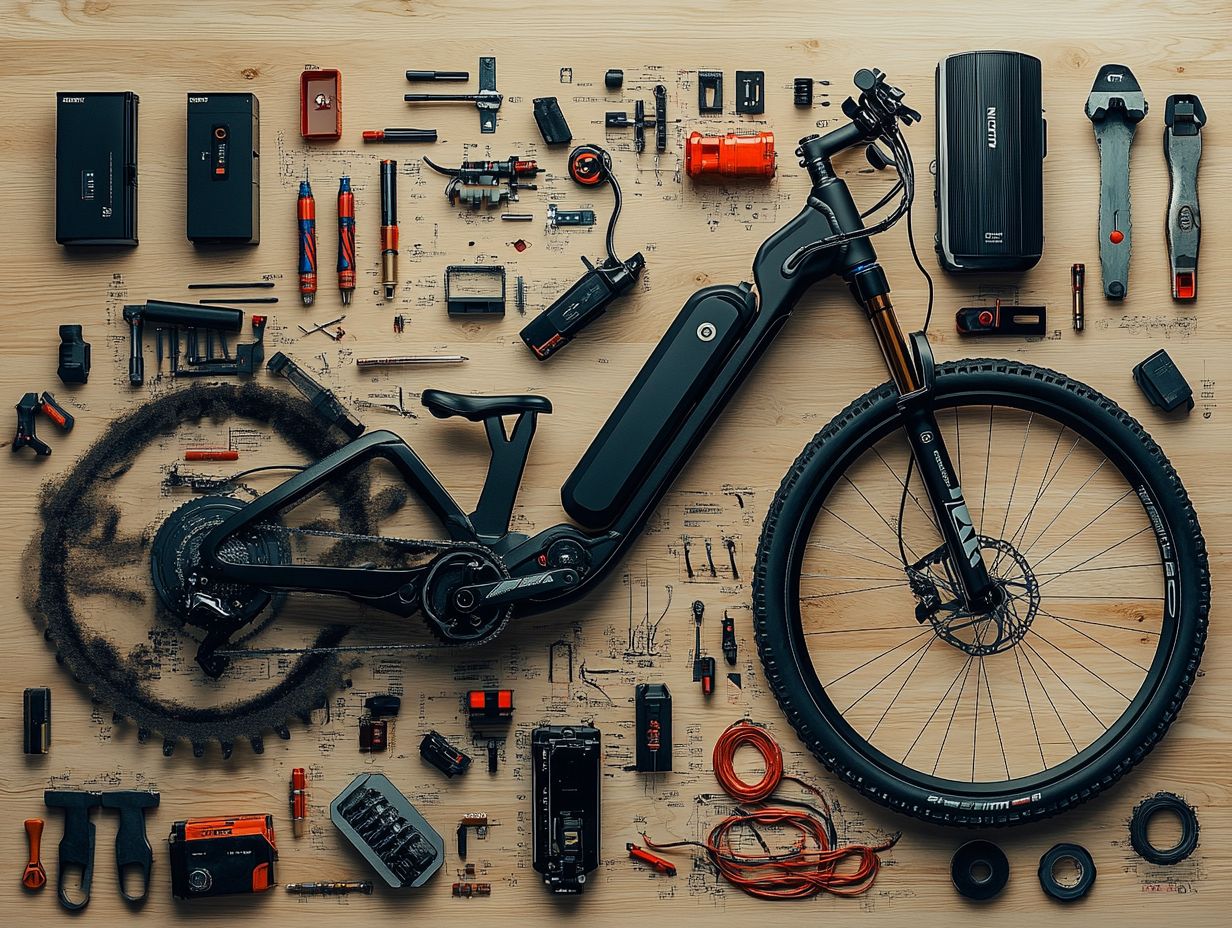
The controller is the brain of your electric bicycle, expertly managing power flow and functionalities like pedal assist and braking that recharges the battery to elevate your riding experience.
It constantly communicates with both the motor and battery. This optimizes performance based on your input and the terrain you encounter.
With various assist modes at your fingertips, customize your ride to match your preferences whether you need full power for steep climbs or eco mode for longer journeys.
Regenerative braking is another smart feature that captures energy during deceleration, sending it back to the battery. This not only extends your bike’s range but also enhances energy efficiency.
The clever interplay of the controller makes your e-bike more effective while ensuring a smooth, enjoyable journey every time you ride.
Display
An e-bike display is your window to essential information, showcasing details such as your speed, distance traveled, and cycling history, all through a user-friendly LCD interface.
These displays often come equipped with handy features like battery life indicators, trip timers, and customizable settings, allowing you to fine-tune your riding experience to suit your preferences.
By providing insights into ride statistics and real-time performance metrics, you can make informed decisions about your journey, ensuring you maintain optimal speeds and conserve battery life when needed.
Throttle
Many electric bicycles offer a throttle as an optional feature, providing you immediate power without the need to pedal often referred to as throttle assist.
This system delivers a quick burst of energy, especially advantageous in bustling urban settings where stop-and-go traffic is the norm.
With throttle assist, you can easily navigate crowded streets or accelerate swiftly from traffic lights, making it an appealing choice for your daily commutes.
One of the standout benefits is the reduction in physical exertion during short trips, allowing you to arrive at your destinations feeling less fatigued.
Be aware of potential drawbacks, such as increased battery consumption and a heightened risk of accidents if you rely too heavily on this feature. Staying aware of your surroundings is crucial while maneuvering through busy cityscapes.
Pedal Assist Sensor
The pedal assist sensor detects your pedaling. It adjusts motor assistance to create a smooth, intuitive ride.
This cutting-edge technology plays a vital role in various assist modes. It gives you the flexibility to choose the level of support that aligns with your riding style or the terrain ahead. For example, switching to a higher assist mode makes the sensor more responsive, delivering a delightful boost of power with every pedal stroke. To learn more about how this technology works, check out understanding the mechanics of electric bikes. This is especially beneficial when tackling steep inclines.
The seamless activation of the sensor enhances efficiency and elevates rideability, making each journey feel effortless. By accurately gauging your input, the pedal assist system transforms standard cycling into an engaging adventure. Understanding the anatomy of electric bicycles allows you to embark on longer rides and explore greater horizons.
How Components Work Together
The various parts of electric bicycles come together to provide a seamless riding experience. Power flow, functionality, and efficiency are finely tuned through the integration of the pedal assist system and other advanced e-bike features.
Power Flow and Functionality
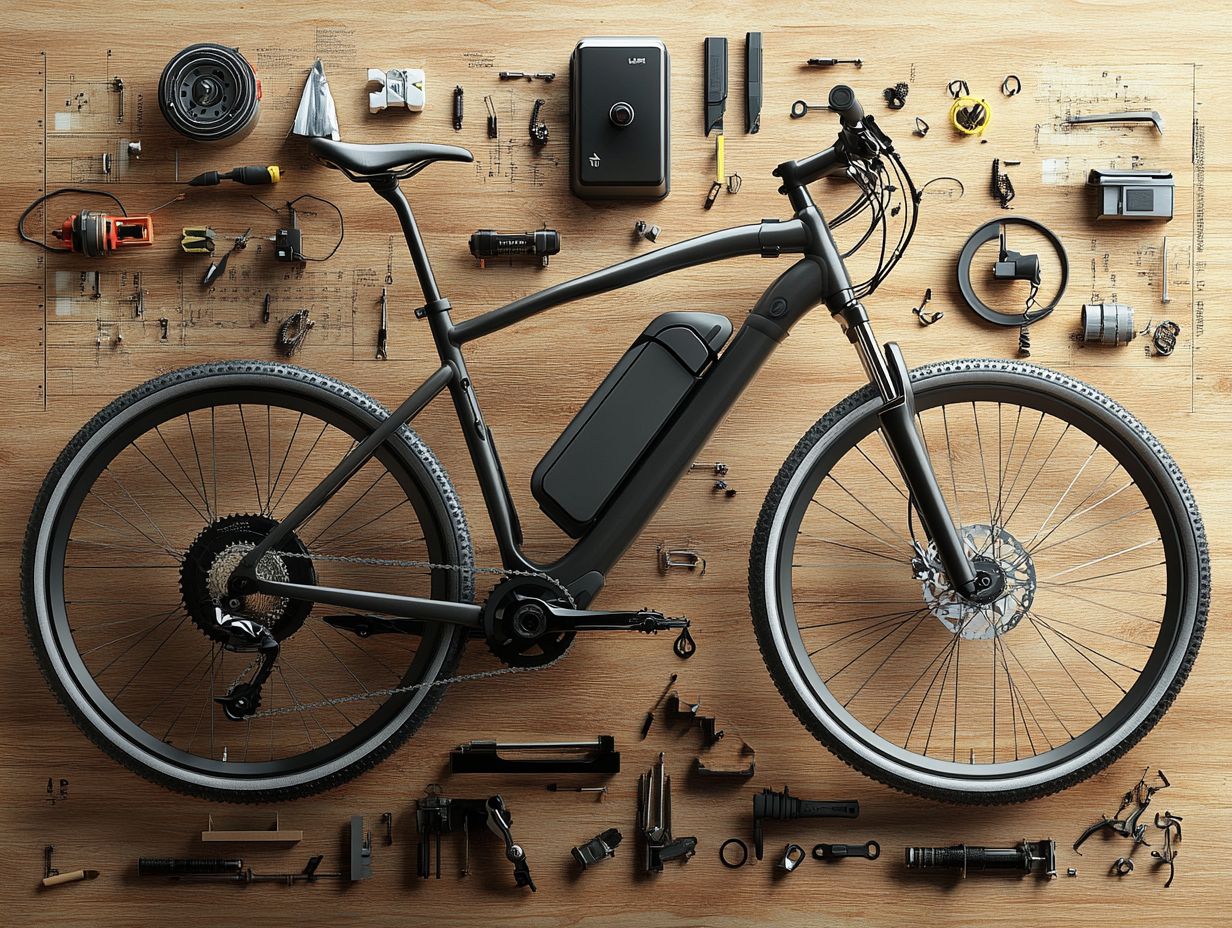
Understanding the power flow within your electric bicycle is essential for optimizing performance and ensuring that each part operates at peak efficiency.
This interaction begins with the battery, which stores energy and supplies it to the system as needed. When you engage the throttle or start pedaling, the controller springs into action. It makes real-time adjustments to the power output based on various sensor inputs. These sensors monitor factors such as speed, cadence (the speed at which you pedal), and terrain, allowing the controller to deliver the right amount of power to the motor. For those interested in more detailed information, check out this overview of hybrid electric bicycles.
This seamless communication maximizes your e-bike’s performance and contributes to a smoother riding experience. To learn more about different options, check out electric bicycle types: a beginner’s guide. Every journey you take will be enjoyable and productive.
Choosing the Right Components for Your Electric Bicycle
Choosing the right parts for your electric bicycle is crucial for optimizing performance, comfort, and overall rideability. Each feature is designed to meet different needs and preferences, ensuring that your riding experience is tailored perfectly to you.
Factors to Consider
When selecting components for your electric bicycle, consider factors like e-bike classes, average price ranges, and technology integration. This will ensure your choices align with your needs.
Understanding the various classes of e-bikes can profoundly influence your riding experience. Class 1 e-bikes offer assistance only while you’re pedaling, making them great for those who enjoy a workout. If you prefer a more relaxed ride, Class 2 models come with a throttle for effortless cruising. For those seeking a thrill, Class 3 bikes deliver higher speeds, satisfying your need for excitement. To learn more about the different types, check out this electric bicycle classification guide.
Technology integration, such as smartphone connectivity and advanced battery management systems, can significantly enhance your ride’s performance and tracking. As you navigate your options, consider exploring the electric bicycle types available and weigh your budget carefully; prices can vary dramatically based on features and brands. Invest smartly to enjoy incredible rides for years to come!
Maintaining and Upgrading Electric Bicycle Components
Maintaining your electric bicycle and upgrading its components on schedule is essential for maximizing longevity and performance. Doing so allows you to fully relish every ride, ensuring that your e-bike delivers the experience you desire.
Tips and Tricks for Longevity and Performance
To enhance your electric bicycle’s longevity and performance, pay careful attention to maintenance. Focus on looking after the bike’s chain and ensuring the brakes are in great shape.
Caring for the battery is also very important. Store your e-bike in a cool, dry place and avoid draining it completely to maximize its life.
Regularly check the motor too. Listen for unusual noises and notice any drop in power, as these can indicate issues like misaligned parts.
Don’t forget tire maintenance. Keep an eye on air pressure and look out for wear or punctures to stay safe on the road.
Flat tires can often be fixed quickly, but complex issues might require professional help to keep everything running smoothly.
Frequently Asked Questions
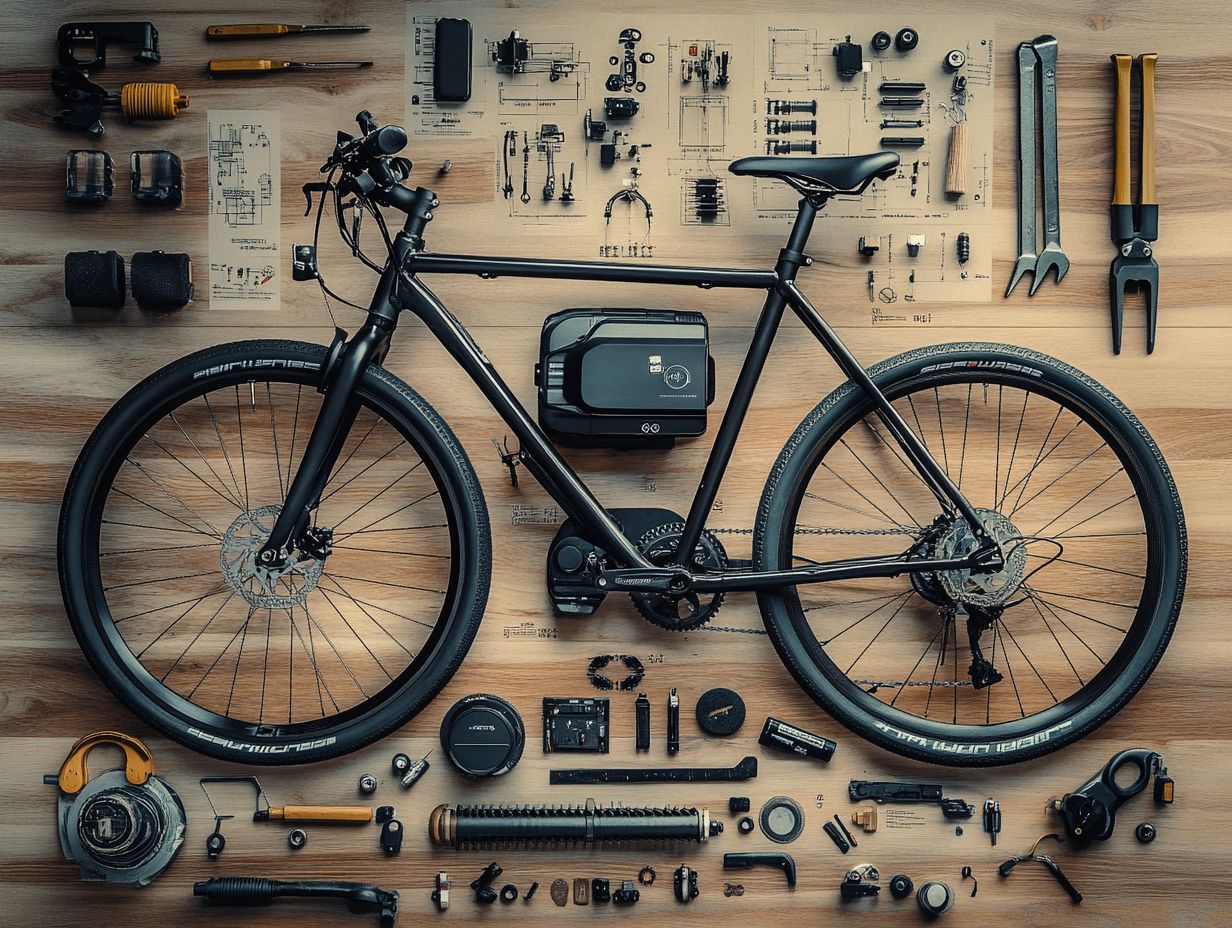
What are the essential components of an electric bicycle?
The essential components include a motor, battery, controller, and display unit. These parts work together to power the bike and allow the rider to control speed and performance.
What is the role of the motor in an electric bicycle?
The motor powers the bike forward and can be located in the front, rear, or middle. Different motors offer various power outputs and torque levels.
How does the battery work in an electric bicycle?
The battery is the energy source. It stores electricity from a power outlet and delivers it to the motor via the controller.
What is the function of the controller in an electric bicycle?
The controller regulates electricity flow from the battery to the motor. It helps control speed and provides important info like battery levels.
Do all electric bicycles have a display unit?
No, not all have a display unit, but it s useful. The display shows speed, distance traveled, and battery level, helping the rider adjust their ride effectively.
Can electric bicycle components be upgraded or replaced?
Yes, many parts can be upgraded or replaced for better performance. Always consult a professional to ensure safety and compatibility.




